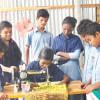Youth unemployment is a growing concern for South Asia

The world's greatest untapped resource is not oil, data, or capital—it's the energy and the potential of the youth. Unfortunately, for millions of young people around the world today, the path from education to employment feels like a dead end. Youth unemployment is hardly a new concern, but its persistence, particularly across certain regions, should alarm us. Even during periods of economic strength, unemployment rates of young people are three to four times higher than those of adults. This is not just a matter of joblessness; it's about the quality and security of work, too.
Today, over 75 percent of young workers globally are trapped in informal jobs, which makes them particularly susceptible to living in poverty and unstable job conditions, including temporary and gig work. The pandemic only deepened these challenges, with its long-term "scarring effects" have hit young people the hardest—disrupting education, career paths, and mental well-being. The International Labour Organization (ILO) estimates that the global youth unemployment rate stood at 13 percent in 2023. The issue is more severe in some regions, such as Sub-Saharan Africa and the Middle East, where youth unemployment rates often surpass 30 percent.
In South Asian countries, the situation is equally pressing, shaped by a very intricate labour market dynamics, and driven by the huge presence of the informal sector and the large influx of people entering the workforce. ILO estimates that youth unemployment (aged 15-24) is high in South Asia, with Bangladesh facing a rate of 15.7 percent in 2023, which is higher than the global average and the low and middle-income countries' average of 14.1 percent.
Therefore, youth unemployment is a regional concern, with India reaching a level of 15.8 percent in 2023. Nepal and Sri Lanka saw even higher rates in the same year, exceeding 20 percent. Among these countries, Pakistan fared slightly better, with a rate of approximately 9.7 percent. Meanwhile, in East Asia, China exhibited a staggering 21.3 percent youth unemployment rate as of June 2023, following a consistent rise over several years. In contrast, Japan has shown a low level of unemployment rate of 4.1 percent in 2023.
Young people who are not in education, employment, or training (NEET) in this region stood at 18.8 percent in 2023. In comparison, East-Asian economies like China and Japan have demonstrated greater success in integrating their youth into the labour force.
Young people today face mounting barriers to securing decent jobs, ensuring fair wages, and accessing stable, good working conditions. Recognising the scale of this issue, policymakers are placing increasing emphasis on improving youth employment outcomes. In response, a range of strategies, targeting both demand- and supply-side labour market constraints, have been deployed across different regions. These include skills development programmes, entrepreneurship support, targeted wage subsidies, and labour market reforms. Strategic international approaches offer Bangladesh a roadmap to overcome the exclusion of youth from meaningful work opportunities.
Vocational training schools: China has invested heavily in the opening up of several vocational training programmes to boost technical skills. Providing vocational training to the youth, which connects theory with practical, real-life skills, is the key to ensuring a better job.
Transition system: Due to increased competition and inadequate job spots, an increasing number of German youths are unable to access Germany's much-lauded vocational training system. In response, the German government has launched the "transition system," which is a collection of schemes designed to provide young people with a bridge between school and the vocational training system. The dual system, which integrates firm-based apprenticeships with theoretical school-based training, remains closely aligned with employer needs and labour market demand. This system has consistently facilitated smooth transitions from education to employment. The country also introduced full-time vocational schools for sectors that are not typically craft or industry-oriented.
Social-welfare approach: The Brazilian authority has introduced social welfare schemes to provide families with financial incentives, which enable youth to continue school longer and delay their entry into the labour market. Youth in Brazil enter the workforce at an early stage without gaining proper education and employable skills that are prerequisites for securing a suitable job and upward mobility. The approach focuses on improving opportunities for the youth employment landscape through reducing inequality, improving wages for low- and middle-income communities, and strengthening the effectiveness of institutions, including education and healthcare. The approaches include minimum wage and collective bargaining, labour inspections and formalisation of work, direct transfers, etc.
Apprenticeships: The US has adopted an apprenticeship model based on a "while-you-learn" approach, leading to a nationally recognised qualification. This workforce development strategy aims to enhance and strengthen employment outcomes for young people by connecting them to long-term, better-paid careers and middle-class jobs. It has been regarded as a key tool for increasing workers' incomes and productivity, while developing a competitive and skilled labour force.
Young people are not only the leaders of tomorrow but also vital drivers of today's socio-economic landscape. Their energy, creativity, and adaptability are invaluable resources that fuel innovation, entrepreneurship, and productivity, which are the cornerstones of sustainable economic growth. As global macrotrends and technological shifts reshape the world of work, Bangladesh must proactively equip its youth with future-ready skills.
The country should adopt targeted strategies focused on skill-building, digital transformation, and youth entrepreneurship. While promising initiatives such as SEIP and YES have been launched to support youth development, there is a further need to scale up investment in skills development by harnessing technology, standardising the education system, supporting start-ups, and encouraging public-private partnerships to mitigate the negative impacts of youth unemployment.
It is a fundamental right for everyone to have access to decent work that enables their families to lead a quality life. To realise this vision, a collective effort from policymakers, businesses, and communities is essential. The stakes are high, but so is the potential. And Bangladesh's future depends on how effectively it empowers its youth today.
Afsara Tasnim is research associate at Research and Policy Integration for Development (RAPID).
Views expressed in this article are the author's own.
Follow The Daily Star Opinion on Facebook for the latest opinions, commentaries, and analyses by experts and professionals. To contribute your article or letter to The Daily Star Opinion, see our guidelines for submission.

 For all latest news, follow The Daily Star's Google News channel.
For all latest news, follow The Daily Star's Google News channel. 










Comments